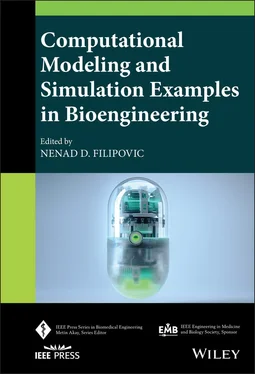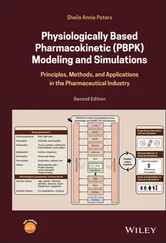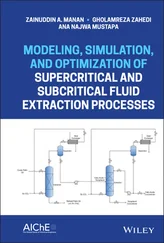Computational Modeling and Simulation Examples in Bioengineering
Здесь есть возможность читать онлайн «Computational Modeling and Simulation Examples in Bioengineering» — ознакомительный отрывок электронной книги совершенно бесплатно, а после прочтения отрывка купить полную версию. В некоторых случаях можно слушать аудио, скачать через торрент в формате fb2 и присутствует краткое содержание. Жанр: unrecognised, на английском языке. Описание произведения, (предисловие) а так же отзывы посетителей доступны на портале библиотеки ЛибКат.
- Название:Computational Modeling and Simulation Examples in Bioengineering
- Автор:
- Жанр:
- Год:неизвестен
- ISBN:нет данных
- Рейтинг книги:3 / 5. Голосов: 1
-
Избранное:Добавить в избранное
- Отзывы:
-
Ваша оценка:
- 60
- 1
- 2
- 3
- 4
- 5
Computational Modeling and Simulation Examples in Bioengineering: краткое содержание, описание и аннотация
Предлагаем к чтению аннотацию, описание, краткое содержание или предисловие (зависит от того, что написал сам автор книги «Computational Modeling and Simulation Examples in Bioengineering»). Если вы не нашли необходимую информацию о книге — напишите в комментариях, мы постараемся отыскать её.
Computational Modeling and Simulation Examples in Bioengineering
Computational Modeling and Simulation Examples in Bioengineering:
Computational Modeling and Simulation Examples in Bioengineering
Computational Modeling and Simulation Examples in Bioengineering — читать онлайн ознакомительный отрывок
Ниже представлен текст книги, разбитый по страницам. Система сохранения места последней прочитанной страницы, позволяет с удобством читать онлайн бесплатно книгу «Computational Modeling and Simulation Examples in Bioengineering», без необходимости каждый раз заново искать на чём Вы остановились. Поставьте закладку, и сможете в любой момент перейти на страницу, на которой закончили чтение.
Интервал:
Закладка:
Venkatasubramaniam et al. [10] refuted traditional views that relate aneurysm size to the risk of rupture. They conducted a comparative study of aortic wall stress in ruptured and non‐ruptured aneurysms with an aim to prove the importance of wall stress when predicting the risk of rupture in individual patients. Namely, the study included computed tomography (CT) scans of 27 patients (12 ruptured and 15 non‐ruptured AAA), predominantly males. Using the finite element method, they calculated wall stress using the geometry of AAA, the material properties of the aortic wall, and the forces and constraints acting on the wall. The material properties were used from a previously validated mathematical model by [39–41]. ANSYS 6.1 program (ASN Systems Ltd, Cannonsburg, USA) was utilized for the analysis and post‐processing while the von Mises stress was used to evaluate the state of the aneurysms. There were no important differences in the mean diameter between two groups (6.8 cm for non‐ruptured and 7.6 cm for ruptured, P > 0.1) and there were two aneurysms that ruptured at small diameters of 5.0 and 5.7 cm. The authors concluded that AAA that ruptured or went on to rupture had significantly higher peak stress (mean 1.02 MPa) compared with non‐ruptured (mean 0.62 MPa). Moreover, systolic blood pressure was also significantly higher in ruptured AAA. Noting that 45 and 65 mm diameter AAAs can have the same stress, they emphasized the role of the shape and asymmetry of the aneurism including the anterior and superior limits. They also demonstrated that wall stress can be calculated from a routine CT scan and that it may be a better predicator of AAA risk of rupture than diameter alone on the individual basis. On the other hand, the study assumed a uniform AAA wall thickness of 2 mm and did not take into account the effect of thrombus on wall stress.
In 2006, Vande Geest et al. [42] developed a biomechanics‐based rupture potential index (RPI) that became a useful rupture prediction tool. Namely, the RPI predetermined the wall strength on a patient‐specific basis by utilizing experimental tensile testing and statistical modeling. The tissue strength was calculated by taking parameters such as age, sex, smoking status, family history of AAA, normalized diameter, and the maximum thickness of the ILT into account. Then, the wall stress was predicted with FEA. Although the authors reported that the RPI has a potential to identify high rupture risk of AAA better than diameter or peak wall stress (PWS) alone, their approach still requires validation before it can be introduced into clinical setting.
In the study conducted by Scotti et al. [43], 10 idealized models of AAA were used, generated with the CAD software ProEngineer Wildfire (Parametric Technology Corporation, Needham, MA) [44] together with an additional non‐aneurismal model as control in order to assess the significance of an arbitrary estimated peak fluid pressure (117 mmHg) compared with nonuniform pressure resulting from a coupled FSI. The models differed in the degree of asymmetry and wall heterogeneity and the FEA was used to estimate the effects of asymmetry and wall thickness on the wall stress and fluid dynamics. Each model contained fluid and solid domain and was analyzed with static pressure‐deformation analysis together with FSI. The Navier–Stokes equations were used as governing equations for homogeneous blood flow, while for computational solid stress (CSS) analysis, only the solid domain was considered. The results exhibited that a realistic fluid pressure distribution to the inner AAA wall (instead of an arbitrary peak systolic pressure) resulted in at least 20% higher wall stress, despite wall thickness heterogeneity. Additionally, maximum AAA wall stress increased with asymmetry although the computational model included blood flow.
Finol and Ender [45, 46] used a Spectral Element Method with three‐step time splitting scheme for the semidiscrete formulation of the time‐dependent terms in the momentum equations for axisymmetric two‐aneurysm abdominal model. This methodology has been widely used for the Direct Numerical Simulation of transitional flows with fast‐evolving temporal phenomenon and complex geometries.
Multi‐scale models for AAA are considered constitutive models for vascular tissue, where collagen fibers are assembled by proteoglycan cross‐linked collagen fibrils (CFPG‐complex) and reinforce an otherwise isotropic matrix (elastin). There is multiplicative kinematics for the straightening and stretching of collagen fibrils. Mechanical and structural assumptions at the collagen fibril level define a piece‐wise analytical stress–stretch response of collagen fibers.
The concept of multi‐scale constitutive model performs integration at the material point for macroscopic stress which takes into account micro plane concept incorporated in the finite element modeling (FEM) [47, 48].
Zhang et al. [49] used multi‐scale and multi‐physical models for understanding disease development and progression, and for designing clinical interventions. They investigated multi‐scale models of cardiac electrophysiology and mechanics for diagnosis, clinical decision support, and personalized and precision medicine in cardiology with examples in arrhythmia and heart failure.
FSI describes the wave propagation in arteries driven by the pulsatile blood flow. These problems are complex and challenging due to the high nonlinearity of the problem. The nonlinearity exists in the fluid equation but also in the structure displacement which modifies the fluid domain and generates geometrical nonlinearities as well [50].
Some authors used the generalized string model as the structure of blood flow in compliant vessels and arteries [50–56]. Causin et al. [57] described this string model as a structural model derived from the theory of linear elasticity for a cylindrical tube with small thickness. Nobile and Vergara [56] emphasized that the generalized string model neglects bending as well. Čanić et al. [58–61] claimed that there are no analytical results which are able to prove the well posedness of FSI problems without assuming the structure model that includes the higher‐order derivative terms, capturing the viscoelastic behavior. For blood flow, there is a strong added mass effect issue in which the fluid and structure have comparable densities.
All the above studies demonstrate the importance of biomechanical modeling of AAA by using FEM approach with and without FSI and nonlinear wall deformation. This mechanical approach provides an additional understanding of potential indicators of rupture risk.
1.4 Experimental Testing to Determine Material Properties
Experimental tests are used to determine the mechanical properties of AAA. In‐vivo measurements are based on the imaging modality. For in‐vivo measurements, the main difficulty is to accurately determine the true force and the displacement distribution for the aorta wall. For isolating samples often unknown changes of their behavior affecting the results of such tests. MacSweeney et al. [62] found that elastic modulus was higher in aneurysmal abdominal aorta compared with controls. More recently, van't Veer et al. [63] estimated the compliance and distensibility of AAA by means of simultaneous instantaneous pressure and volume measurements obtained with the magnetic resonance imaging (MRI). Ganten et al. [64] by using time resolved electrocardiography (ECG)‐gated CT imaging data from 67 patients, found that the compliance of AAA did not differ between small and large lesions. Molacek et al. [65] did not find any correlation between aneurysm diameter and distensibility of AAA wall and of normal aorta. Uniaxial extension testing is the simplest and most common of ex‐vivo testing methods. The recorded force‐extension data are converted to stress/strain. Di Puccio et al. [66] provided a recent review of the incompressibility assumption on soft biological tissue. Biaxial test was used as an initial square thin sheet of material which is stress normally to both edges. Even this test is not sufficient to fully characterize anisotropic materials [67, 68], although it can capture additional information regarding the mechanical behavior of the specimens with respect to uniaxial one.
Читать дальшеИнтервал:
Закладка:
Похожие книги на «Computational Modeling and Simulation Examples in Bioengineering»
Представляем Вашему вниманию похожие книги на «Computational Modeling and Simulation Examples in Bioengineering» списком для выбора. Мы отобрали схожую по названию и смыслу литературу в надежде предоставить читателям больше вариантов отыскать новые, интересные, ещё непрочитанные произведения.
Обсуждение, отзывы о книге «Computational Modeling and Simulation Examples in Bioengineering» и просто собственные мнения читателей. Оставьте ваши комментарии, напишите, что Вы думаете о произведении, его смысле или главных героях. Укажите что конкретно понравилось, а что нет, и почему Вы так считаете.












